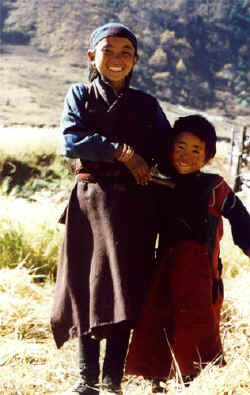MyHimalayasimpressions from |
|
|||||||
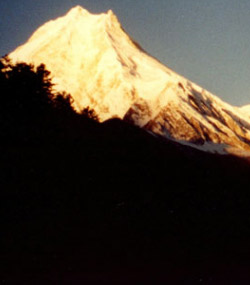
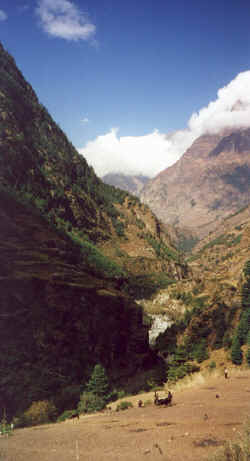
At first the Nupri valley is narrow but after two days will open up and large
fields will grow on the more gentle valley walls.
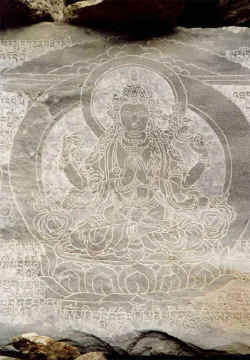
Delicate carvings depict entire scenes of Buddha's life and admired deities.
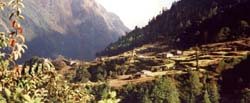
Lihi village gives us a first taste of the lovely villages ahead.
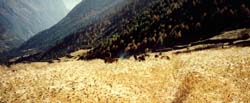
People are harvesting ripe barley in the wide terraced fields above their
villages.
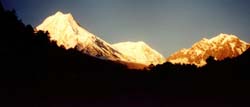
The valley still lies in darkness when the sun hits the top of Manaslu and its
satellites.
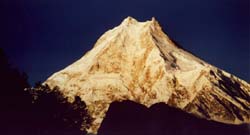
The subtle changes of the light on the ice are terrific, turning from grey to
pink to orange to yellow and then the 'regular' white.
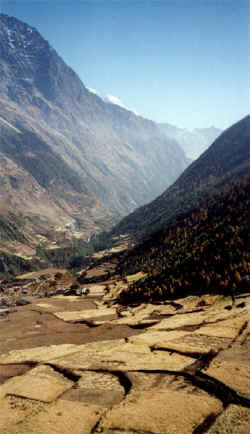
Lho is a large village, surrounded by dense pine forests and many fields
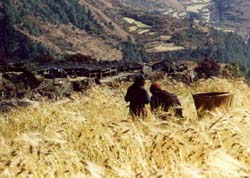
The barley is ripe and people are busy harvesting from early in the morning
until late in the evening. Mostly women and children work on the fields, the men
are away on trade in Tibet.
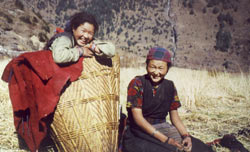
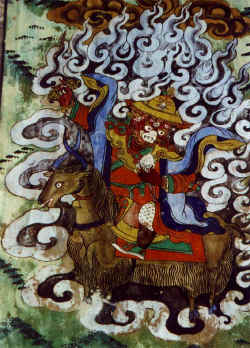
The mani wall at the town's end is probably the longest one in the area. The
white-washed chorten features excellent paintings.

One of the may detailled and nicely-coloured figures depicted on the inner wall
of the chorten.
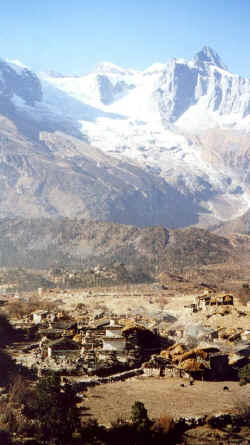
Sama village is situated in the wide valley at the foot of Manaslu and its
glaciers.

Once again the sunrise is beautiful, Manaslu does not appear to be 8'000 meters
high from Sama.
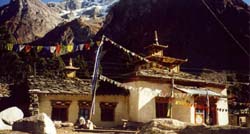
The monastery in Sama is in regular use and very well-kept. The paintings on
wooden panels are fantastic, the mural paitings equally well done.
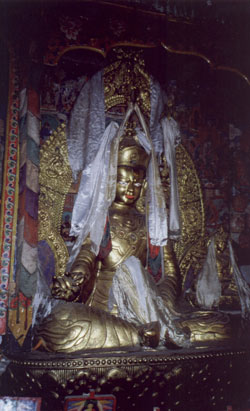
Statue of Guru Rinpoche in the main hall of Sama monastery.
Manaslu: Bim Phedi - Sama
Bim Phedi - Lho - Sama
Bim Phedi - Ghap (Day 11)
Some knees are hurting (surprisingly enough, not mine), otherwise everybody is fine. This will be an easy half-day walk since the group needs to be re-united and the loads have to re-distributed. Dana and Dagmar arrive for breakfast, they camped a little further down. Half a rest day is pleasant after yesterday's tough walk.
Luckily the weather is brilliant when we get up late. Non-trekking people will never understand what is so special about days like this: Sleeping in, getting up just as the sun hits the tent, having breakfast in a T-shirt, taking a bath and letting yourself dry by the sun, then putting on freshly washed clothes. Half a day of such luxurious leisure is a well-enjoyed rarity.
The walk to Ghap will take only some hours, so we have lunch at Bim Phedi and start after dessert. The valley is still narrow but the absence of dense forests makes it seem wide and open. Villages, their fields and the wild scenery are a nice contrast. Fields of red, green and yellow grow on the steep walls. Mani walls with nicely carved stones depicting the life of Buddha, long texts or Taras are the cultural highlights.
After a narrow gorge with impressive washouts high above the water level the valley bottom becomes wider and flat. Ghap is surrounded by large fields, a picturesque site with a snow peak far away. The trail passes the village in some distance and follows the river, the end of the village is marked by a whitewashed chorten and building with colorful rural paintings containing a large prayerwheel. More mani walls with fine rock carvings have been erected just before the bridge.
I am afraid to have walked too far and climb one of the huge boulders overlooking the trail to wait for the others. A strange looking animal with a long tail and black and white fur is walking around the gompa. It is much too big for a weasel but definitely not a monkey or a large cat either. Tenzing thinks it is a kind of mongoose that lives solely on chicken blood.
We cross the bridge and get to a nice-looking lodge and campsite half an hour outside of Ghap. A Buddhist monk performs a ceremony in the living room, assisted by two small boys. They carry the offerings out of the room, walk around a juniper-fire a few times and throw the tsampa figures into the air. After the ceremony is over I play with the two brothers - using the remains of the tsampa offerings as a toy. This is probably not very sensitive, but the kids really enjoy it. All I can say in my defense is that the only other throwable objects are stones, and that is definitely not a good alternative to tsampa.
High above on the steep cliff is another settlement, only visible because of its bright white chortens (Kokwa Gompa). Prok and its monastery are worth a sidetrip, but I enjoy a lazy evening at camp instead of walking up to the village.
Ghap - Namru - Lho (Day 12)
While dozing off I imagine to hear rain on my tent, but when I get up at night the stars shine brightly on the clear sky. The first thought in the morning is 'having more chicken curry'. No, I am not considering giving up vegetarianism, but the cock that wakes me up would not be able to do that had it been cooked the day before.
The trail is muddy at first as follows the river upstream through dense forest. After crossing the river at an impressive spot where it thunders down a narrow gorge, the forest becomes less dense and the trail is fine again. Green grass grows between big conifers, pine needles on the ground make it an easy and quiet walk, you cannot even hear your footsteps. Soon later a white summit rises high above the colorful trees. The creek is dropping steeply over large boulders; the white water is a nice contrast against the varicolored plants and the deep blue sky. The pleasant walk continues and after a last steep climb we reach Namru, from where I expect a great view over a wide valley. Well, the village is nice, but the open spaces are still some hours away. The golden barley fields and glaciers on the ridges high above it are a good enough reward, to say the least. To the south rises a huge peak, probably Himal Chuli. If you follow a similar itinerary try staying at the campsite here and walk up to Lho the next day.
None of us is too happy that we meet another group. They probably feel the same way about us, but I would like to think that my disliking them is based on facts because they walked around the chorten counter-clockwise. When people don't spend time at home learning about the country they will visit, well, I find it strange but some seem to be very busy. But if you cannot even follow the most basic cultural conventions (consciously or for lack of knowing) after being in the country some days, you should have stayed at home. At least the French group serves as a reminder how fortunate we are to be in an area almost devoid of tourists.
Another group that has lunch at the creek is a research team from Kathmandu. They visit Sama monastery for a few days to microfilm old scripts. After looking for rare old Tibetan Buddhist literature in all parts of Nepal for many years, Sama will be the last monastery they visit. When they first started 30 years ago, their 'activities' were often met with suspicion by the local communities, and lamas were reluctant to show the century-old books to foreigners. But after some explanations they agreed, and these days they get a small amount of money (3 to 6 rupees for each page, 10 pages = 1$). Sometimes the lamas bring the scripts to Kathmandu. But often that is not possible and the team visits the monastery and does the microfilming there. Carrying the camera, strong lights and generator creates quite a few jobs for porters. The German project leader spent the last six years in Nepal, often hiking in remote areas: we have been to many of the same places and find out we even have common acquaintances. A Tibetan scholar is with the team, and also a monk from Sama who came to meet them. I hope to hear more of their profound way of explaining whole scenes of mural paintings at Sama.
The area is more densely inhabited; a few scattered houses are down at the valley floor where people are working in the yellow fields. Climbing steadily in the shade of a forest takes us to Lihi, a fine village with many chortens and many barley terraces. I am tempted to explore a monastery further up, but we still have quite some way to go to Lho. Ganesh Himal rises high into the sky when we turn around. The main valley straight ahead is getting wider and fields cling to both walls, a smaller valley is joining just after the village. The trail drops and crosses the sidevalley of Simnang Himal. The creek's water is used for irrigation, large pipes made of entire trees and trenches transport the precious water to the fields above Lihi. The trek was great so far, but now we reach the area I had in mind when I decided to come on this trek.
A chorten with detailed paintings announces Sho, another nice village with fine views up the open valley. The building that clings to the rock face must be a monastery, some isolated white chortens and a house or two with no fields around it stand on a small ledge next to a narrow gorge.
Clouds have built up at the end of the valley, when they become less dense I am stunned by a huge wall of ice that rises above Lho. What I took to be fog was in the fact the massive peak of Manaslu. I just stand there and watch in awe. The town is built on a ridge high above the valley and looks like a fort from far away. The traverse is an gentle walk, apart from a washed out sidevalley it is an easy hike in lively and interesting surroundings.
Almost everywhere grows ripe barley. Small watchtowers are in the fields to chase away animals. A rustle in the trees startles me for a second, I did not expect such a close encounter with a big Langur monkey. Two minutes the watchtower in use, an old woman throws stones at a whole Langur clan that raids her barley field. The work is incredibly hard and tiring, singing makes it more pleasant and occasionally they sit down for some tsampa and butter tea.
Walking in the dusk again is not a nice prospect so we continue without taking long breaks. Some locals are also on their way home and carry large baskets of barley or hay, but on many fields the work will continue until it gets dark. One final steep slope needs to be climbed and then we reach the houses that are lined up on a ridge. I am surprised to see even more houses. Usually villages get smaller the higher you are, here it is just the opposite. The older part of town is lying on a gentle hillside and is surrounded by endless terraces, a large forest of green and yellow larches separates them from the cliffs further up. The buildings all look very similar; solid stone houses with slate as roof, wooden balconies and large courtyards. Young animals are kept in there, the stacks of firewood are almost as high as the large haystacks in front.
People in the large fields look like small dots in the yellow terraces, their laughing and singing can be heard from some distances. The campsite is on a little plateau above the village, on the way there we pass a fine chorten and a chest-high mani wall a hundred meters long.
It is getting chilly and the porters are at least an hour behind. Instead of sitting in the smoky kitchen I go for some more exercise to stay warm. After a short introduction to harvesting I 'help' on a nearby field. The barley ears are cut off on the field, thrown in a large basket and then flailed in the courtyard. When all the fields have been harvested, people start cutting and collecting the hay. With a sickle the plant is ripped out and put on piles. I am doing a terrible job at first but the lady keeps encouraging me and after fifteen minutes I do not miss too many sheaves. Doing hard work in a crouching position is too much for a back that is used to sit on an ergonomic chair ten hours a day. But it is a great way to mingle with the villagers and sometimes leads to invitations or shared meals. I wish we had more time for these kinds of things, but I am so fortunate to be here that there is no reason to complain.
After it got dark the porters arrive, I wonder if they are angry with Bharat because it was another very long day for them.
It is considerably colder than just a day ago, but the Sherpa stew gives enough warmth. While lying in the cozy sleeping bag I already imagine the stunning views of tomorrow. Wild dogs howl from the forest as I fall asleep.
Lho - Sama (Day 13)
At least one of the wild dogs has enough courage to visit the campsite, its howling probably woke up everybody. When I get out soon later the scenery is breathtaking. Bright stars illuminate the massive pyramid of Manaslu, a white triangle in the black night.
I wake up before the alarm rings - which I set too early anyway because I was afraid to miss the sunrise. Shortly before 600 the color of snow and ice on Manaslu changes to a strange, clear white. Some minutes later the very top of the pinnacle is pink, changing to orange as more of the mountain gets hit by the sun. When half of the pyramid is illuminated, the ranges next to it also turn orange while the rest of the valley is still in the dark. This is the only indication of how enormously big the mountain really is, its summit is 4'500 m above us.
Our next camp in Sama is only half a day further west, this leaves plenty of time to spend in Lho and do some of the exploring we didn't have time for yesterday. Before breakfast I walk down to the village to enjoy the fantastic views, the silhouettes of the houses and their smoke look lovely in the backlight. The mountains with the chorten and mani wall are even more remarkable. Male yaks with wide horns are driven down to the village where a large herd is tethered to pegs in the ground. Most of them carry saddles for mounting loads, the larger yaks have colorful strings in their ears. Soon they will set out for Tibet, crossing easy passes to the trading places on the high plateau.
The town's meeting place is in front of the gompa. A dozen people, mostly men and old women, sit in the sun and argue about läga (work), I wonder why they are not on the fields. In (former) Tibet and Ladakh harvesting is often done by a community thing, the fields belong to a family but people help each other. Here it is often just two or three people working in one field, though maybe that is because they just started and there is enough work of everybody. Maybe after a family finishes their own fields they start helping their neighbors. The men are probably about to go trading and wait for more yaks to get back.
The caretaker is also there and lets me in the monastery. Only the very upper part is from the old monastery, everything else was renovated. The number of books is large, an adjacent buildings holds the complete collection of scripts of the Kandjur and Tandjur, supposedly even in two different scripts.
After an hour in the village I walk up to the fields. Everybody assumes I lost the way and points to the other trail. They are surprised when I tell them that this is a great spot to spend some time. Not only are the great views of the fields and the colorful forest above it pleasant, but the people are really nice. Harvesting is done mostly by women. The older women are more reserved at first, but communicating with the kids and the girls is easy and fun. After some minutes their mothers or older sisters join and we share some snacks and tea. Time passes very quickly and I should catch up with the rest of the group, they already left for Sama awhile ago after visiting the school. I climb the steep hill near or camp, assuming that the trails lead to a monastery, but only a construction site is up there. When I asked people they said there is a gompa up there, maybe this is where it will be one day. Or maybe they meant Pungyen Gompa, half a day up a ridge overlooking the glaciers.
The Buri Gandaki is far down and has a turquoise color now, but we will follow a small tributary instead. There are plans to install a electricity generator, a aisle is cut through the forest to put up the power poles. Large trees are being logged, a dozen tough looking men load timber onto yaks. Bringing wood to Tibet is a very lucrative business, it is traded for wheat which is brought back to their village Lho. With their help I find the trail to Sama again, after some minutes in mud along a shallow creek I catch up with our group.
Walking in the shady fir forest is very enjoyable. After picnic below a steep ice-covered ridge that rises above the green treetops (Ngadi Chuli?) it is just a short climb to a plateau and the village Shyala.
Logging is a thriving business in Shyala. Forty wooden cabins are either shops or logger's houses, most of the trees around the village were already cut down. It is a sad and pathetic place, though the scenery is the most impressive we have seen so far. Huge mountains surround us, Himal Chuli and Peak 29 (recently renamed to Ngadi Chuli) to the left, Manaslu and large glaciers straight ahead, other snow summits to the right, at the far end of the valley we have just come from stands Ganesh Himal. An amphitheater of snow and ice! But the boomtown is a reason not to stay long. The logging seems uncontrolled, which is surprising because we are in a conservation area, supposedly there is even a government office monitoring logging.
After the coming out of he forest and crossing a washed-out sidevalley a wide plain lies in front of us, surrounded by large mountains on all sides. Harvesting season is over, otherwise the barren fields would look even prettier. From a large chorten we look down into a little dip where two rows of houses form the main part of Sama. The large mani pile and white chorten produce the effect of feeling welcome when walking on the trail with pretty houses to both sides. At the far end of the village, overlooking the valley, stands the well-known monastery of Sama. It is worth a long visit tomorrow.
It is one of the few monasteries that still attract a large community of nuns and monks. They live in their own small houses that are built around the gompa, each has a small living room to the left and a slightly larger private chapel to the right. The living room serves as kitchen, storage room and bedroom, therefore it is really cramped and smoky. The chapel is kept very clean and is very cozy, I was thinking about staying in a house the two nights we are here, but the tent will be much more comfortable.
The campsite on the 'outskirts of Sama' is behind the monastery, close to the glacier that comes from Manaslu. The ice moves constantly, small avalanches are the most vivid sign of its force, though the strange sound seems even scarier than the avalanches.
Sama - Restday (Day 14)
Beautiful sunrise again, but it was much colder than just a day ago and I don't get up to take pictures. I do not feel very well. I cannot say what is wrong, but something just feels strange. Therefore I give up my highflying plans of a tough sidetrip to Pungyen Gompa, a monastery with great views of the glacier. It is named after Manaslu, Pungyen means bracelet, a good description of the two peaks. It was destroyed a year after the first unsuccessful Japanese attempt to climb Manaslu. The locals believed that the climb angered the gods, and when the Japanese came back a year they met so much resistance that they had to give up their attempt. They finally summitted in 1959.
But to walk back to Shyala and then up the ridge would be too much for me now, I opt for the easy sidetrip to the glacial lake instead. Since there seems to be no path to the glacier, Tom, John and I bushwhack for some time before we find a trail that goes up to a small ridge. Below us is a green lake with small icebergs, a vertical wall of rock covered by ice builds its far end. The glacier goes up steeply first but then takes a left turn from where a steep ridge goes to the summit of Manaslu. A local herder is watching the yaks that stand in the icy water to cool off. While trying to get to the spot for the picture I slip - or more exactly, the trail just slides down - toward the creek. My hand suffers a little after the successful attempt to avoid a freezing bath. Luckily it is only scratches and after washing off the blood in the ice-cold water it stops hurting. (And yes; the picture of the yak in the river with the glacier and Manaslu peak in the background was worth it.)
The other want to climb further up to the glacier, but I am feeling not any better - on the contrary - and I decide to turn back, planning to take a nap and maybe visiting the village in the afternoon. I feel weak but cannot fall asleep, after some hours I finally throw up, and go to bed again. I do feel better now, but have fever during the night and weird, weird dreams. But at least I sleep and the strange feeling in my stomach seems to have disappeared the next morning.
|
Summary Part 3:
During the next two days in the valleys we pass mani walls with hundreds of fine carved stones depicting religious scenes. The gorge slowly changes into an open valley and settlements become larger and more numerous. The Tibetan villages are surrounded by wide golden barley fields where people are harvesting. From Lho we have the most stunning views of Manaslu. Full-moon illuminates the pyramid-shaped mountain at night, during sunrise the view of the world's 8th-highest mountain are terrific. On a plain just below Manaslu's glaciers lies Sama, another village with a highly interesting monastery that attracts a large number of older nuns and monks. |
